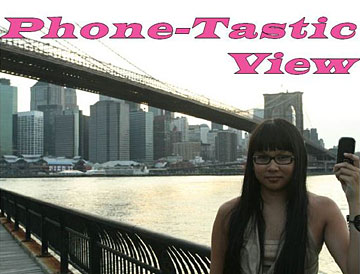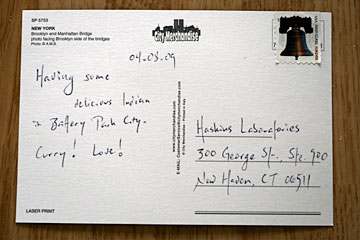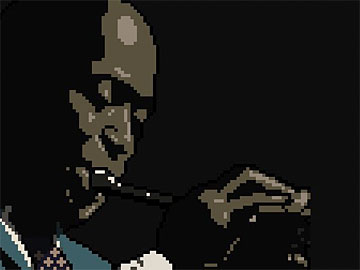July 7, 2009. It’s the middle of summer, and I’ve just heard from the folks at the DUMBO Arts Center that my installation proposal, Phone-Tastic View, has been approved for the 13th Annual DUMBO Art Under the Bridge Festival. I’m thrilled, of course, but now I’m up against a new problem: how on earth am I going to pay for this? The installation calls for a standard street sign to be installed on the waterfront. The sign would instruct viewers to send a text message to receive quirky information about the view of the skyline, so I also need to fund the text messaging service. After adding up the numbers, I’m realizing this will cost at least 500 dollars.
That’s when I learn about Kickstarter, a new site for artists to help them crowdsource fundraising, Obama-style, through small donations. What follows is an interview with Yancey Strickler, co-founder of Kickstarter, interweaved with the story of my own fundraising efforts for my first public art installation, along the Brooklyn waterfront.

An Xiao: Tell me a little about the origins of Kickstarter. What, if you will, kickstarted this idea?
Yancey Strickler: Our CEO/co-founder Perry Chen came up with idea when he was living in New Orleans a few years ago. He was trying to put on a concert for the New Orleans Jazz Festival, but in order to make it happen he needed to front a lot of money.
He thought that there’s clearly another way to do it without fronting the money out of pocket. If only he could know demand before he started. So he got the idea of a conditional transaction—you only start the project if you raise enough to fund it. He and I met about four years ago and we started working on applying this idea.
AX: So it started in classic Internet start-up style, with two people and an idea. But now you have a team of five.
YS: Yes, Perry and I were the first two. Then we met Charles Adler, a user experience designer. He designed the whole site. Lance Ivy, the technical founder of User Voice, developed it. Andy Baio joined us as chief technology officer after first serving as an adviser. He runs the very popular Waxy.org, and previously founded a company (Upcoming) that Yahoo eventually purchased. And our primary adviser is Sunny Bates, who just knows everyone and has just been incredible with us. She’s been very helpful in making the site successful.
We’re all spread around the country. Only once have we all been in the same room.
AX: Wow. Where was it?
YS: Shortly after the site launched, we flew everyone into New York. But even then we only had time for us all to sit down together once.
AX: Sounds like we need to get a Kickstarter page going for your reunion.

The promotional image I used for "Phone-Tastic View" on Kickstarter
August 12, 2009. After returning from a few weeks in Los Angeles, I’m ready to begin fundraising for the project. People are slowly coming back from summer travels, I’ve just checked out the installation site, and I’m feeling good. Setting up a Kickstarter page turns out to be a cinch. It’s just like setting up a Facebook page—I upload a photo and post a quick pitch about the project—and I link up my existing Amazon account with the Kickstarter system, to ensure I can easily receive the funds.
I spend the most time deciding on the backer rewards, the work that backers will receive in exchange for their donation. As my installation has as its backdrop the famous Manhattan skyline, I decide to center the rewards around that. Those who give $10 will receive a postcard of New York City taken from a previous conceptual installation I did at Yale/Haskins Laboratories. Those who give $15 and $25 will receive a print of the DUMBO installation, with the skyline in the background. And those who give $100 or more will receive a larger print and do a site visit with me at the festival space.
I launch my Kickstarter page, share the link via my social networks, and cross my fingers…
AX: So why now? Your site has been quite popular as of late–what is so appealing about it over other fundraising sites for creatives?
YS: The timing is right for something like this, for a lot of reasons. The current economy makes it harder to get the initial money for a project. There’s also a growing, broad movement for a fuller understanding of where the things we consume and enjoy come from. We also talk a lot about affinity commerce – the idea that you’re not just buying a thing. You’re buying to be a part of something. You’re buying a story. We’re looking for that authentic experience, so we can say, “This is happening, and this was my role in it.”
AX: Why should an artist choose Kickstarter over other sites?
YS: We worked really hard to build a site that we would use. All of us have wanted something like Kickstarter in the past. We wanted to build something that had a brand that’s not in your face and doesn’t mettle with the user. It’s a platform built to serve the needs of our users, and nothing more complicated than that.

A postcard from a previous installation at Yale/Haskins Laboratories. The other side is an image of the skyline. This was the backer reward for $10.
August 13, 2009. Two days later, and I’ve only raised $75. Three very generous backers have supported my work, but I am far, far away from my ultimate goal of $500. Visions of international travel and an early retirement quickly fade from my mind. Now I’m just hoping to raise a little bit more and save face.
In the mean time, Sew Helpful, which started at the same time as me, has already raised more than it needs. “What am I doing wrong?” I ask myself in despair. I feel just a tiny bit better when I realize it’s run by Mena Trott, co-founded and president of Six Apart. It helps to have a broad network, doesn’t it?
The reason I’m stressing is because of the Kickstarter structure: you have to raise the goal amount by your deadline date or none of your money—I repeat, none of it—is received. You can fall just a dollar short, and your backers will not be charged.
AX: The all-or-nothing element strikes me as unique amongst most fundraising sites I’m familiar with. Why that approach? Why not just let artists keep what they’re able to raise, even if they fall a dollar short?
YS: At first glance it might seem draconian. What we found is that it dramatically increases the amount that people are able to raise. Add a ticking clock and some temporality and everyone is extra-motivated.
Normally when you’re asked to be a part of a fundraiser, it’s annoying, fatiguing, or it’s open-ended. Having the all-or-nothing approach helps motivate people. It forces you to focus on what you need and how you frame your project.
And the real benefit to this is that it lets people conditionally test things: see how much interest there is in your idea. You’re only on the hook if you’re successful.
AX: And your backers don’t have to pay if you don’t reach your goal.
YS: That’s right. It really helps with getting backers to spread the word. One statistic we’ve trotted out in the past is holding true so far: if a project reaches 25% of its funding goal, it has a 90% chance of eventual success. That’s a function of the all-or-nothing approach. Once you get that core 25% group of backers to start, they become the street team, and they tell all their friends and it starts spreading three and four degrees from you. And that’s when you win.
AX: I found that all my backers came from my Twitter following, rather than the site itself. What’s to keep an artist from just organizing a project on their own and fundraising via their social networks? In other words, why use Kickstarter?
YS: Kickstarter is built to raise money for projects. Our project pages are built for that one and only purpose. People have been trying adding tip jars or PayPal buttons for years, but they simply don’t work.
I have a great PayPal button example: there’s this guy who first started floating the Obama birther theories last year. He put up the website expounding on the theories and had a PayPal button the entire time. It asked readers to give some money to help with this research. He had the button up for two years, but about a month and a half ago, he angrily took down the whole site. That entire time he had only raised something like $37.
Having a tip jar up there or something passive just doesn’t work. But take Trent Reznor from Nine Inch Nails — he recently sent out a Twitter message saying that he was raising funds for a friend with a heart condition. He said it was only happening for a day or two, and he offered things like dinner with the band in return. He raised somewhere around a million dollars.
Now, of course Trent Reznor can do that because he’s an established star. But the framework of how he presented this is very similar to how Kickstarter functions. Not only do you have to act within a certain timeframe, but you’ll get something rewarded in exchange as well.

One of the more successful Kickstarter projects, "Kind of Bloop: An 8-Bit Tribute to Miles Davis," created by Kickstarter's Andy Baio, gained 411 backers and raised $8,648—over four times more than the projected $2,000 goal.
August 24, 2009. I’ve sent out tweets to my 1,300 followers. I’ve messaged my 600 Facebook friends. I’ve e-mailed my mailing list. I’m 40% to my goal so far, and many of my friends have posted about my work and encouraged others to give, but I’m still falling short. I feel as if my fundraising efforts have hit a plateau. Granted, I’ve set a high bar: most successful Kickstarter projects I’ve seen have had a clear visual or musical end-product, and I’m sharing out a vague conceptual art project.
In a mild panic, I email Yancey and ask him if I can lower my goal, or if I can change the deadline date. I’ll take the few hundred I’ve raised, even if it falls short of the full $500. But he tells me in no uncertain terms that will not be possible—once you’ve set an amount and a date, you can’t go back. There’s no Undo button here: you’re in it to win it.
It’s time to take drastic measures…
An’s concludes her conversation with Yancey Strickler and her experiences with Kickstarter in a second post tomorrow available here. —Ed.




Pingback: Kickstarting Creative Projects: An Innovative Micro-Giving Site, Part 2 of 2 | Art21 Blog
Pingback: What’s Cookin at the Art21 Blog: A Weekly Index | Art21 Blog